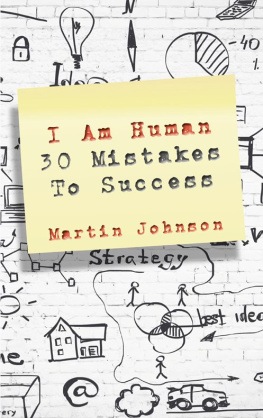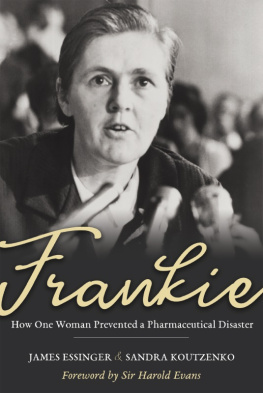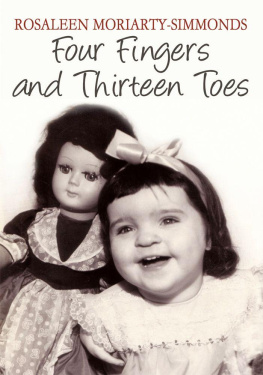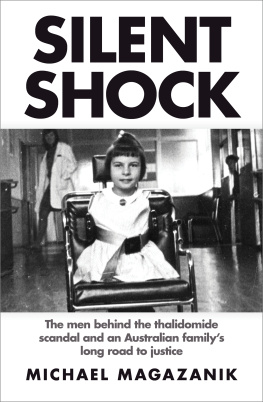The Thalidomide Catastrophe
How it happened, who was responsible and why the search for justice continues after more than six decades
Martin Johnson, Raymond G. Stokes, Tobias Arndt
Onwards and Upwards Publishers
3 Radfords Turf, Exeter, EX5 7DX, United Kingdom
www.onwardsandupwards.org
Copyright Martin Johnson, Raymond G. Stokes, Tobias Arndt 2018
The right of Martin Johnson, Raymond G. Stokes, Tobias Arndt to be identified as the authors of this work has been asserted by the authors in accordance with the Copyright, Designs and Patents Act 1988.
All rights reserved.
No part of this publication may be reproduced or transmitted in any form or by any means, electronic or mechanical, including photocopy, recording or any information storage and retrieval system, without permission in writing from the authors or publisher.
This first edition is published in the United Kingdom by Onwards and Upwards Publishers (2018).
ISBN: 978-1-78815-630-1
Graphic design: LM Graphic Design
PUBLISHERS NOTE
The views expressed in this book are those of the authors and do not necessarily represent or reflect the views of Onwards and Upwards Publishers.
Acknowledgements
This book has been produced with help from a vast number of people, both those within the worldwide thalidomide community survivors, those affected by the drug and those who only first engaged with the subject during the time we were working. The authors are grateful to all who have helped in any way. The Thalidomide Society (UK) is the organisation which provided the main foundation for the work, with its invitation to present the early material during their meetings in 2010 and 2011, but especially at the 50th anniversary event in London, on 26 May 2012. The presentation delivered on that occasion was the basis for chapter one. The Contergan Society of North Rhine-Westphalia was another body providing much information and encouragement. Support from Contergan (thalidomide) survivors in Germany has been very strong, and the first public airing of the authors argument that the thalidomide drug was most probably not invented at Chemie Grnenthal GmbH was at a combined meeting of the German Contergan Societies in Berlin, on 26 November 2011. In addition, there has been the support from virtually all the thalidomide organisations representing survivors around the world, including FfdN of Sweden, TVAC of Canada, the Ishizue foundation of Japan, and the societies representing Australia, Austria, Belgium, Brazil, Ireland, Italy, the Netherlands, Norway and Spain.
Individuals who have helped with testimonies and historical and other information include thalidomide survivors Monika Eisenberg-Geginat, Bjorn Hkansson, Claudia and Udo Schmidt-Herterich, Andrea Kornak, Mercedes Benegbi, Shoshana Duizend-Jensen, Leigh Gath, Fred Dove and Phil Williams. Parents of thalidomide children giving new evidence include Michael Carr-Jones and Sadie Galvin. Michael Howard, a former T-Force officer, directed us to the organisations post-war debriefs of German scientists held at Duxford. We are also grateful for information and encouragement supplied by the former Sunday Times journalists Bruce Page and Sir Harry Evans; supporter Jonathan Stone; and researchers Inge Mecke and Ruth Ziegler.
Assisting the project in different ways were thalidomiders Geoff Adams-Spink, Nick Dobrik, Guy Tweedy, Craig Millward, Rowland Bareham, Stevie Sinclair and Wendy Tomes, together with several other members of the thalidomide campaign group and the Thalidomide Trusts National Advisory Council; also Thalidomide Trust chairs Sir Michael Wright and Sir Robert Nelson with the support of the other trustees.
For help with the medical and scientific aspects of the work, we wish to thank Drs. Claus G.H. Newman, Janet McCredie, Harald Mckter, Elizabeth Horak, Tosca Kinchelow-Schmidt, E. Clive Joseph and Professor David Healy.
The work has involved a considerable amount of archival research, and we wish to thank the staff of the following archives for their considerable help: Imperial War Museum, Duxford, Cambridgeshire (UK), the Bundesarchiv (German Federal Archives) at Koblenz and Berlin (DE), the Landesarchiv NRW, Duisburg (DE) and the Archiv der Sozialen Demokratie, Bonn (DE).
We have been particularly grateful to Dr. Ruth Blue (Thalidomide Society) in her efforts to track down people prepared to supply their personal photographs, and to all those individuals themselves. Trevor Beattie of BMB has generously provided his time and talents in creating our cover design and some of the graphics used inside.
This work has taken more than eight years to bring to completion, and it is possible we may have not included everyone who has helped. If we have overlooked anyone, we ask their forgiveness, and trust that the accuracy and importance of the narrative will be what matters.
Martin Johnson, Raymond G. Stokes, Tobias Arndt
Saint Ives, Glasgow and Brussels
October 2017
Contents
Foreword by Sir Harold Evans
I could never forget the brave sweet innocence of the infants at Chailey Heritage hospital and school in Sussex. The youngest in 1962 were only three, attempting to navigate a strange new world with their limbs foreshortened, short shoulder flippers instead of arms, toes from their hips, or no limbs at all. They were a few among the thousands of infants worldwide attacked in the womb by the poisonous pill we know as thalidomide. It was patented in 1954 by Chemie Grnenthal, the German company headed by Hermann Wirtz (1896-1973) and his family in the Rhineland town of Stolberg. Hermanns firm had prospered as part of the Dalli Group in the Nazi era, making soap and detergents for the Wehrmacht; Aryanisation enabled them to take over Jewish businesses for little money, forced and slave labour was on tap. Postwar, with high demand for penicillin, they tried their hand at pharmaceuticals. They patented their thalidomide compound as Contergan, promoted it as non-toxic, no side effects, completely non-poisonous and completely safe, better than all other tranquillizers for relief in pregnancy from morning sickness and sleeplessness. They licensed it in 79 countries under no fewer than 49 different brand names.
Every one of them was a lie.
This momentous book, teeming with revelations, is the first comprehensive history of thalidomide. It takes us from its murky origins in the Nazi era to the shadows behind its fateful move into pharmaceuticals, Wirtzs conduct in the catastrophe, and his astounding escape in his criminal trial. The three authors came together one by one I think of them as three gallant Musketeers. Martin Johnson was for 21 years a pilot in the Royal Air Force, before flying high as the director of the UK Thalidomide Trust in 2000, navigating so well the survivors have an average income of 50,000 a year. Tobias Arndt, an unstoppable researcher, was moved to offer his services to Johnson and the UK thalidomide campaigners after seeing the moving German documentary Eine einzige Tablette (Just a single tablet). And Johnson recruited as the third Musketeer the renowned historian of IG Farben, Professor Raymond G. Stokes, at the Centre for Business History in Scotland at the University of Glasgow.
I salute them. I have written extensively on thalidomide, along with my Sunday Times colleagues in the seventies. In January 1973, with allies in Parliament, thalidomide families and the City, we finally won compensation ten times the dismissive offer made by the whisky bottlers Distillers, who marketed thalidomide as Distaval under licence. Three and a half years later, the European Court of Human Rights freed us to publish our investigations on the causes of the disaster suppressed by the British government. In 1979 we published the Insight Teams
Next page








